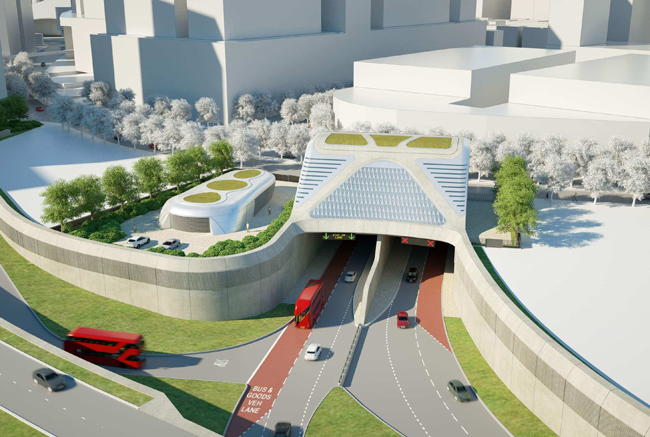Transport for London (TfL) has dropped a longstanding pledge to run 37 cross-river buses in East London after opening the Silvertown tunnel, with a likely knock-on effect on traffic.
Although it has been known for a while that the scheme will open with just 20 buses per hour in each direction, the cash-strapped transport authority has now dropped pledges of an increase to 37 per hour and said that any future increase will be ‘in response to demand’.
The starting point of 20 buses per hour will mean just 14 extra buses per hour on top of six already running through the existing Blackwall Tunnel, instead of a promised 31, and may only be reached during peak hours.
This contrasts with repeated promises of 37 buses from both TfL and London mayor Sadiq Khan and reverses their previous approach that a high level of bus provision will stimulate public transport take-up.
For example, in June 2019, Mr Khan told the London Assembly: ‘By having a tunnel that has a lane reserved for buses - it will start with 20 buses an hour going to 37 an hour - you will have public transport going from one side to the other side, encouraging more people to use public transport.’

What Mr Khan described as 'a lane reserved for buses' is not in reality reserved for buses
With both TfL and Mr Khan having repeatedly emphasized the ability of the new tunnel under the Thames to open up new bus routes and their role in reducing an anticipated increase in car traffic, the reduced service will make it harder to deliver controversial pledges that traffic will not increase.
TfL is in serious financial difficulty, which it says has largely resulted from a severe, and continuing, fall in passenger numbers caused by the pandemic, particularly on buses.
It did not respond directly to a request to clarify whether it has the funding to provide the new 37.5 new bus services per hour on which its traffic model for the scheme’s Development Consent Order (DCO) was based. However, a spokesperson said: ‘TfL is committed to running at least 20 zero emission buses per hour when the new tunnel opens, and will increase the number of buses over time in response to demand.
‘A public consultation on the final proposals will be carried out ahead of the new or extended routes launching to align with the tunnel opening in 2025.’
TfL documents suggest that the lower level of 20 buses per hour, which would match its minimum obligation under the DCO, may only run during peak hours.
A report to TfL’s Programmes and Investment Committee last October stated: ‘We are planning to run at least 20 zero-emission buses per hour through the tunnels at peak times from Scheme opening.’
It added with significantly less certainty: ‘We expect the overall provision of buses through the area could increase to 37 buses per hour over time.’
The transport assessment for TfL's 2016 DCO application stated that ‘new and extended cross-river bus routes, amounting to around forty buses per hour in each direction, could be provided which would considerably improve PT accessibility in the areas served either side of the river’.
A paper put to the Silvertown Tunnel Implementation Group in January acknowledges that TfL based its transport assessment and traffic modelling on 37.5 buses per hour through the Blackwall Tunnel and the new tunnel and that during the DCO process it had undertaken sensitivity tests for ‘several 20bph networks’ in relation to economic outcomes (public transport user benefits); modal shift; and traffic changes.
The paper stated that TfL had recently modelled plans for 20 buses per hour, adding that ‘by running further sensitivities it is expected this initial bus network will evolve’.
It also noted that another stipulation of the DCO was that TfL must secure a cross-river bus service provision using the tunnels that would deliver ‘the same or greater levels of public transport benefits’ as its modelling had promised.
It added that the ‘early indications’ of new modelling based on the 37.5 buses per hour used for the DCO ‘suggest this will result in lower public transport user benefits’.
The paper states that TfL will develop new analysis to forecast how the planned bus network performs against above categories relative to the 37.5bph network in the DCO modelling, with the objective of demonstrating the same or greater levels of public transport benefits’.
Register now for full access
Register just once to get unrestricted, real-time coverage of the issues and challenges facing UK transport and highways engineers.
Full website content includes the latest news, exclusive commentary from leading industry figures and detailed topical analysis of the highways, transportation, environment and place-shaping sectors.
Use the link below to register your details for full, free access.
Already a registered? Login